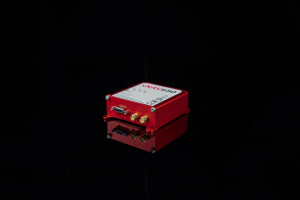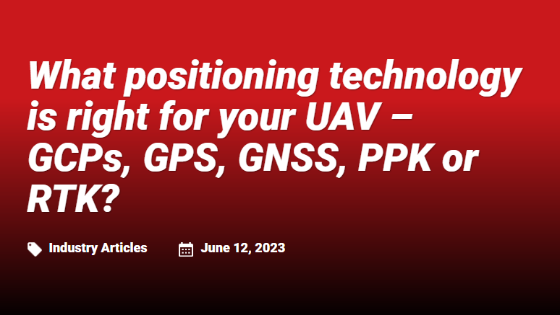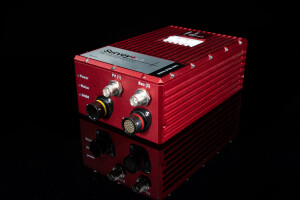

What Positioning Technology Is Right for Your Uav – GCPS, GPS, GNSS, PPK or RTK?
If you’re in the market for a survey UAV or drone, you’ll no doubt be knee-deep in technical specs as you try and evaluate different models (or even different components, if you’re building a UAV payload from scratch). But, what positioning technology is right for your UAV? One of the things you will be evaluating is, of course, accuracy. Accuracy is important for two reasons. Firstly, you want your UAV to be where it’s supposed to be and secondly, you want to be able to accurately georeference the data you’re gathering with your payload.
But (as you will no doubt have already discovered), accuracy isn’t as simple as looking for a number. You’ll have spotted various acronyms accompanying those numbers – GPS, PPK, RTK, and GCP most commonly, but you may also see GNSS thrown into the mix. In this article, we’ll explain what these acronyms mean – and what they mean for your UAV project.
What are GCPs?
GCP stands for Ground Control Points, and they are the most inexpensive method of ensuring your data is accurately georeferenced. They are physical targets that you place on the ground, and which you know the GNSS coordinates for. Once your UAV has finished its survey, those points can be used to reference the position of your UAV in the global frame.
The biggest drawback with GCPs is that they don’t help your UAV know its own position. GCPs only help provide your UAV with a general position reference. So GCPs aren’t of any use if you want your UAV to fly pre-programmed flight plans. For that, you’ll need a GNSS-based solution like an INS.
GCPs can also be time-consuming to use and cause additional difficulties at the post-processing stage.
What is GNSS?
The biggest drawback with GCPs is that they don’t help your UAV know its own position. GCPs only help provide your UAV with a general position reference. So GCPs aren’t of any use if you want your UAV to fly pre-programmed flight plans. For that, you’ll need a GNSS-based solution like an INS.
GCPs can also be time-consuming to use and cause additional difficulties at the post-processing stage.
Many UAVs will have a GNSS receiver built in – it’s what enables them to know where they are on the planet, after all. Using GNSS only, most drones can get an accuracy of 3-5 metres. This level of accuracy isn’t too bad for some applications, but definitely not accurate enough if you’re trying to use the position data for mapping activities.
What is PPK?
Most drones advertise PPK capabilities – and it stands for Post-Processed Kinematics. It’s a method of squeezing extra accuracy out of your GNSS signal. We have a blog here that describes how it works (we talk about RTK, which we also cover below, but the principles are the same).
The main thing to note about PPK is that you can’t use it in real-time. Drones with PPK capabilities can provide data that’s centimetre-level accurate in optimum conditions, but that accuracy can’t be used for navigating the drone itself. It also means that for activities that require centimetre-level accuracy in real-time, PPK doesn’t deliver.
What is RTK?
RTK is the best you can get when it comes to position accuracy. RTK stands for Real-Time Kinematic, and just like PPK it can get you centimetre-level accuracy – but in real-time, rather than in post-processing.
For most mobile mapping activities RTK accuracy is the goal, particularly if you’re using a LiDAR sensor to create
georeferenced point clouds.
Without RTK accuracy for the duration of your LiDAR survey, your point cloud may be unusable. The additional accuracy RTK offers could be used to tackle more challenging environments – providing you have the tools to remain with RTK accuracy for as long as possible in the absence of GNSS.
Most off-the-shelf UAVs won’t have RTK capabilities built in, however, to get this level of accuracy, it’s likely that you’ll either need to purchase a top-of-the-range UAV, or invest in a custom UAV (either built by you or by a professional company).
What's right for me?
Generally speaking, if you’re involved in mobile mapping activities then at the very least you will need PPK capabilities. Without those, you won’t be able to georeference your data with enough accuracy to be of use to anyone.
When considering the difference between PPK and RTK, you need to consider:
- What environment is your drone operating in? Do you need more accuracy than just a GNSS signal (remembering that PPK can only be applied after the survey takes place)
- Is range of particular importance – or is the payload on your drone sufficiently large that you need to calculate range very carefully? If so, then RTK will give your drone additional accuracy and so fuel efficiency.
The final word in accuracy: gx/ix PPK and RTK from OxTS
I’ll finish up this blog by mentioning an additional technology developed by OxTS to give our INS devices the best accuracy possible. If you read the blog above, you’ll know that RTK (and PPK) rely on having an optimal number of satellites visible. If those satellites are lost, then so is RTK lock. That is, unless you use an OxTS INS with gx/ix Tight Coupling technology. gx/ix allows our INS devices to maintain RTK and PPK level accuracy even if the number of visible satellites starts to drop. Essentially, it protects the accuracy of your scan for longer – and it is available on the OxTS xNAV650, our drone-mountable INS.
The OxTS xNAV650 INS combines a best-in-class inertial measurement unit, with a survey-grade GNSS receiver to output highly accurate navigation data (position, heading, pitch and roll). The xNAV650 is used across the world for applications where reliability and accuracy are critical.
I hope this article has helped you understand more about the different ways UAVs calculate their position and the benefits of each method. If you’d like to discuss anything else to do with how your UAV can provide the most accurate data possible (without breaking the bank), get in touch with us today.
Do you have questions about this case study?
Get in touch with Oxford Technical Solutions - OxTS, and they would be happy to answer any questions you have about pricing, suitability, availability, specs, etc.









![Do-Giant-Tortoises-Make-Good-Neighbors-1[1].jpg](https://cdn.geo-matching.com/vRMO2Edp.jpg?w=320&s=a6108b2726133ff723670b57bc54c812)



